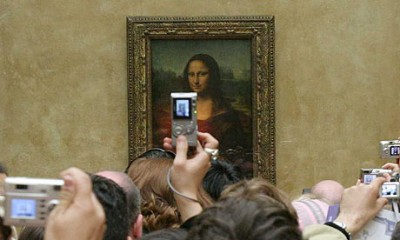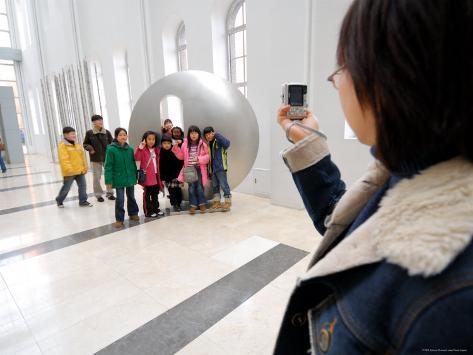
Museumgoers snapping photos of Vincent van Gogh’s Starry Night, 1889, at MoMA. ©2013 REBECCA ROBERTSON
From Carolina A. Miranda via Art News:
We’re in an age when people take pictures just about everywhere, an act that photography critic Jörg M. Colberg describes as “compulsive looking.” The phenomenon has created a unique set of challenges for art museums, many of which have historically had strict limitations on photography — either for the purpose of protecting light-sensitive works or because of copyright issues.

Diane Madden, center, leads Trisha Brown dancers in “Roof Piece Re-Layed” at the Modern photo: Ruby Washington/The New York Times
But the ubiquity of digital cameras, along with the irrepressible urge to take pictures, has led many museums to revise their policies in recent years. “You are fighting an uphill battle if you restrict,” says Nina Simon, director of the Santa Cruz Museum of Art & History and author of The Participatory Museum. “Even in the most locked-down spaces, people will still take pictures and you’ll still find a million of these images online. So why not support it in an open way that’s constructive and embraces the public?”
Certainly, there are practical reasons for doing so – no-photo policies can be difficult to enforce. What’s more – social media further complicates the issue. This Pew Research Center’s Internet & American Life Project reported that 97 percent of the more than 1,200 arts organizations it polled had a presence on platforms like Twitter, YouTube, and Flickr. New York’s Museum of Modern Art, for example, posts photos of artworks and installation processes on Facebook (where it has around 1.3 million followers), the Massachusetts Museum of Contemporary Art has photos of its Sol LeWitt wall drawings on Instagram, [and the list goes on].

a typical day's viewing in front of the Mona Lisa at the Louvre museum in Paris. Photograph: Lydie France/EPA
With museums sharing so much imagery themselves, it can be difficult for visitors to understand that they can’t necessarily do the same. “If a museum is really active on social media, they’re putting forward the idea that they represent a venue that is all about being conversational,” says Simon. “For the visitor, it can be disturbing to then go to the physical space and be confronted with a policy that isn’t.”
The biggest hurdle to wide-open photo policies is the issue of copyright. Museums often do not hold the copyrights to the works they display, which creates legal problems when visitors start snapping away. But with the deluge of cameras, along with the fact that the vast majority of visitors simply want to snap a pic for a Facebook album, has led some institutionsnto ask lenders for permission to shoot, with the stipulation that pictures are for noncommercial use.
“There’s an undeniable benefit to having visitors tweet about their visit or share photos,” says Brooke Fruchtman, associate vice president of public engagement at LACMA. “We’ve had great success with our Stanley Kubrick exhibition because people could take pictures of anything.” For more than a year, the museum has allowed photography in its permanent-collection galleries. Still, for temporary shows, permission ultimately rests in the hands of the lender, as in the case of Caravaggio’s Toothpuller, which is owned by the Galleria Palatina at the Pallazzo Pitti in Florence.
As a culture, we increasingly communicate in images. Twenty years ago, a museumgoer might have discussed an interesting work of art with friends over dinner. Today, that person is more likely to take a picture of it and upload it to Facebook.
This transformation in the way in which people digest visual stimuli — not to mention the rest of the world around them — is something that Harvard theoretician Lawrence Lessig has described as a shift from “read-only” culture (in which a passive viewer looks upon a work of art) to “read-write” culture (in which the viewer actively participates in a recreation of it). The first step toward recreating a work of art, for most people, is to photograph it, which, ultimately, isn’t all that different from the time-honored tradition of sketching.
You can also find Carolina A. Miranda at C-Monster.net
Related articles











Comments (0)